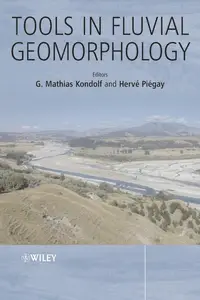
Free Download Tools in Fluvial Geomorphology By
2003 | 679 Pages | ISBN: 047149142X | PDF | 9 MB
In recent years there has been a marked increase in funding and employment in river restoration. Methods in Fluvial Geomorphology provides an integrated approach to the interdisciplinary nature of the subject and offers guidance for researchers and professionals on the tools available to answer questions on river management on very difference scales. * Each chapter is organised to cover everything from general concepts to specific techniques * Topics covered include evolution of methods, guiding concepts, a framework for deciding when to apply specific tools, advantages and limitation of the tools, sources of data, equipment and supplies needed, and a summary table * Provides the professional with a useful handbook covering all tools used in fluvial geomorphology * Also provides valuable information on the advantages and limitations of the tools * All chapters include case studies to give examples of the applications of the tools discussedContent: Chapter 1 Tools in Fluvial Geomorphology: Problem Statement and Recent Practice (pages 1-22): Dr G. Mathias Kondolf and Dr Herve PiegayChapter 2 Surficial Geologic Tools in Fluvial Geomorphology (pages 23-57): Dr Robert B. Jacobson, Dr James E. O’Connor and Dr Takashi OguchiChapter 3 Archaeology and Human Artefacts (pages 59-75): Dr Anthony G. Brown, Dr Francois Petit and Dr Allan JamesChapter 4 Using Historical Data in Fluvial Geomorphology (pages 77-101): Professor Angela M. Gurnell, Professor Jean?Luc Peiry and Professor Geoffrey E. PettsChapter 5 System Approaches in Fluvial Geomorphology (pages 103-134): Dr Herve Piegay and Professor Stanley A. SchummChapter 6 Analysis of Aerial Photography and Other Remotely Sensed Data (pages 135-170): Dr David Gilvear and Dr Robert BryantChapter 7 Geomorphic Classification of Rivers and Streams (pages 171-204): Dr G. Mathias Kondolf, Dr David R. Montgomery, Dr Herve Piegay and Dr Laurent SchmittChapter 8 Modelling Catchment Processes (pages 205-230): Dr Peter W. Downs and Dr Gary PriestnallChapter 9 Radiogenic and Isotopic Methods for the Direct Dating of Fluvial Sediments (pages 231-267): Dr Stephen Stokes and Professor Des E. WallingChapter 10 Vegetation as a Tool in the Interpretation of Fluvial Geomorphic Processes and Landforms in Humid Temperate Areas (pages 269-288): Dr Cliff R. Hupp and Dr Gudrun BornetteChapter 11 Measurement and Analysis of Alluvial Channel Form (pages 289-322): Dr Andrew Simon and Dr Janine CastroChapter 12 Flow Measurement and Characterization (pages 323-346): Dr Peter J. WhitingChapter 13 Bed Sediment Measurement (pages 347-395): Dr G. Mathias Kondolf, Dr Thomas E. Lisle and Professor Gordon M. WolmanChapter 14 Use of Tracers in Fluvial Geomorphology (pages 397-423): Dr Marwan A. Hassan and Dr Peter ErgenzingerChapter 15 Sediment Transport (pages 425-461): Dr D. Murray Hicks and Dr Basil GomezChapter 16 Sediment Budgets as an Organizing Framework in Fluvial Geomorphology (pages 463-500): Dr Leslie M. Reid and Dr Thomas DunneChapter 17 Models in Fluvial Geomorphology (pages 501-537): Dr Stephen E. Darby and Dr Marco J. Van de WielChapter 18 Flow and Sediment?Transport Modeling (pages 539-576): Dr Jonathan M. Nelson, Dr James P. Bennett and Dr Stephen M. WieleChapter 19 Numerical Modeling of Alluvial Landforms (pages 577-595): Dr James E. PizzutoChapter 20 Statistics and Fluvial Geomorphology (pages 597-630): Dr Pierre Clement and Dr Herve PiegayChapter 21 Integrating Geomorphological Tools in Ecological and Management Studies (pages 631-660): Dr G. Mathias Kondolf, Dr Herve Piegay and Dr David Sear


